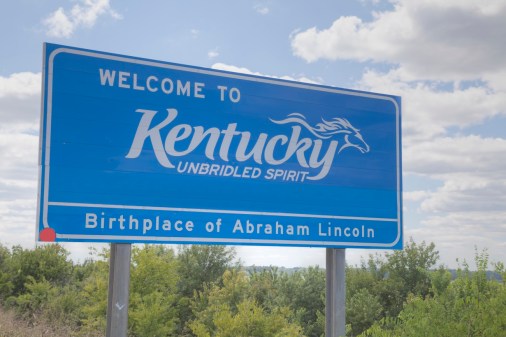How transitions, cyber and collaboration shaped 2015

For the state information technology community, 2015 was a year of change.
More than 20 chief information officers cycled in and out of their positions, just as many governments started ramping up their defenses against ever-changing cyberthreats. At the same time, government IT as a whole evolved, and states and cities across the country found new ways to collaborate, either internally or externally, to boost efficiency and change how they operate.
In this StateScoop Special Report, we take you through the stories that shaped the year, and that set the tone for what to expect from the government IT community going forward.
Washington, D.C., pioneered new data sharing partnerships with Waze to improve traffic flow in the city and began piloting a system involving the use of smartphones to track city buses in real time.
A StateScoop study, underwritten by HP, found that state IT executives are struggling to meet their established goals around mobility. In fact, 72 percent of respondents said mobility was a high or mid-level priority at their agency, but only 57 percent said their agency had a mobility strategy.
At the federal level, President Barack Obama announced initiatives to expand municipally funded broadband based on the example set in Cedar Falls, Iowa.
For the first time, IT officials from Texas and Indiana partnered with eGovernment service provider NIC to host a multistate hackathon.
Later on in the month, the Federal Aviation Administration announced a new set of rules for commercial unmanned aircraft system use, and the White House partnered with Delaware and 21 cities to launch the TechHire initiative.
Through an initiative spearheaded by now-former Chief Information Officer Paul Baltzell, Indiana used big data and analytics to find ways to reduce the state’s high infant mortality rate.
On the East Coast, Philadelphia became the first state to use Meerkat — and eventually other live-streaming mobile applications — to broadcast city press conferences and meetings online.
In April, StateScoop hit the road. First, StateScoop traveled south to learn about city CIO Samir Saini’s efforts to make Atlanta a fiber-enabled smart city, and then to California to hear how state CIO Carlos Ramos was using technology to help the state address its massive drought.
Virginia, taking a cue from an Obama executive order, announced the first state information sharing and analysis organization.
In the lead-up to their midyear conference, the National Association of State Chief Information Officers released a study that reported 86 percent of CIOs were struggling to recruit new employees to fill vacant IT roles. At the midyear conference, StateScoop honored 50 innovative IT leaders and programs as a part of the annual StateScoop 50 awards.
Arkansas broke new ground when it released the first state government app for Apple Watch.
Later in the month, the Federal Communications Commission announced that schools and libraries across the country would receive the full $3.9 billion requested from the E-Rate program.
NASCIO also issued a call to state CIOs to help their state officials guide how unmanned aircraft systems will be integrated into the national airspace ahead of official rulemaking from the FAA.
With highly publicized clashes between police officers and the public over the past year, states and municipalities are struggling to figure out whether to use body cameras. In fact, a year-end StateScoop analysis found that state bills on body cameras soared in 2015. But a June StateScoop report showed that even if localities adopt body camera policies, questions still remain on how to store and manage the massive influx of data.
Tony Scott, the federal CIO, spoke to an Amazon Web Services Government symposium about state CIO requests for common APIs for federal government services — something Scott said he thought made “obvious” sense.
In June, news of a major breach at the federal Office of Personnel Management hit the mainstream media, leaving states questioning their own cybersecurity postures. Several state C-suite IT executives told StateScoop what they were doing to prepare for a similar breach at their states.
Read: A state-by-state review of how elections and retirements altered state CIO lineups in 2015.
In a series of two reports, NASCIO told states to make it easier for disabled citizens to use state websites, apps, videos and other technology services.
NASCIO called on the U.S. Senate in August to act on the Geospatial Data Act of 2015, saying that federal agencies were not fulfilling their obligation to share and contribute geospatial data to the public, or to states. The bill has yet to pass.
The First Responder Network Authority, a federal organization aiming to develop nationwide public safety broadband network, appointed a new president and CEO.
On the eve of the Smart Cities Council “Smart Cities Week,” the White House pledged more than $160 million for smart city federal research projects and promised to support dozens of collaboration efforts to drive innovation in cities.
Technology officials at the federal Transportation Department also expressed its desire to create a publicly accessible database of the geographical location for every address in the country.
At the NASCIO Annual Conference in Salt Lake City, the Information Technology and Innovation Foundation released a report saying that states could save $11 billion over five years with information technology. NASCIO itself released its annual 2015 state CIO survey, which said CIOs were moving toward a service broker model of IT delivery.
The city of San Francisco launched the first wireless network specifically designed for Internet of Things technology.
StateScoop released its first list of 10 smart cities to watch, which highlighted the cities using innovative technologies to improve operations and save money. Amid growing interest in edtech, StateScoop’s parent company Scoop News Group also launched a new publication called EdScoop, which tracks the rapid technology changes impacting school districts and college campuses across America.
More than a year into its seven-year cloud computing transformation project, Pennsylvania said it needed to rethink how it budgets for cloud to save the state money.
The three gubernatorial races in November held the potential to shake up the CIO spots in Louisiana, Mississippi and Kentucky. And, indeed, after Kentucky’s election, the state’s well-regarded health care exchange faces an uncertain future. In 2016, 12 state governorships will be up for election.
Less than four years away from the end of its 13-year agreement with Northrop Grumman, Virginia is already looking at a new model for its IT outsourcing agreement. A report recommended the state move away from a single IT infrastructure provider and adopt a multi-supplier model.
In Georgia, the secretary of state’s office got into hot water after it mistakenly released voters’ personal information.
Proposed voting changes in Maine could have major IT implications for the state’s voting machines, the state’s deputy secretary for state for elections said. Maine voters will decide in 2016 whether to proceed with plans to use ranked-choice voting over their current system.
A year-end analysis of legislative activity found that state lawmakers introduced twice as many bills involving cybersecurity issues in 2015 over the previous year.
Read: A state-by-state review of how elections and retirements altered state CIO lineups in 2015.






